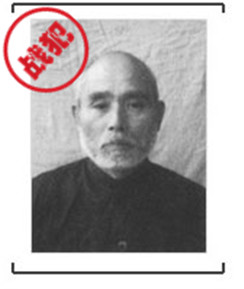日本战犯上坂胜侵华罪行自供
2020-03-08 10:51:36 来源:中央档案馆 点击: 复制链接

一、笔供内容提要(中文)
据上坂胜1954年7月笔供, 他1892年出生于日本大分县。1934年3月—1941年11月,在台湾任步兵联队的队副、大队长,军阶为少佐、中佐。1945年6月任陆军第59师步兵第53旅少将旅长。同年8月20日在朝鲜咸兴附近被苏军逮捕。
重要罪行有:
“1942年2月间,我任步兵第163联队联队长,在河北省保定县盘踞的时候”,把“逮捕、监禁的中国人约有20名”,“用斩杀、刺杀等方法进行杀害”。“3月左右”,“因京汉铁路望都站和清风店站中间地区约10公尺的铁轨被拆去”,“捉了10余名嫌疑者,经拷问而杀害3、4名”。“5月左右”,“望都附近的铁路沿线(望都西方约1公里)的一所炮楼发生被八路军急袭遭覆灭”,“拷问了居民30名,杀了通谋者6名,并将接近炮楼之3栋民房放火烧之”。“6月左右”,因在望都又发生炮楼被八路军袭击遭覆灭的事情,“拷问了很多的居民,杀害了5名通谋嫌疑者,并烧了数栋民房”。
1942年5月27日,在冀中作战中,于河北定县东南22公里处,“我指使第1大队杀害了八路军战士、居民约达800人以上”,“使用了赤筒和绿筒的毒气,受到机枪扫射的不只是八路军战士,而迷失逃跑路途的居民也被射杀了。又在村里进行了扫荡,向逃入很多居民的地道里掷入赤筒和绿筒的毒气,以至窒息,或者是对感到痛苦而逃出的居民,即施以射杀、刺杀、斩杀等残酷行为”。冀中“侵略作战的结果,给与中国人民的损失是:杀人约1100名,破坏房屋10栋,烧毁3栋,把450栋的房屋掠夺使用了10天的时间,并酷使中国人民240名修筑8个炮楼(约10日间)”。
1943年春,在河北行唐西北方山区,第2大队共“杀害八路军和居民约250人,烧毁房屋约50栋”。“各部队(前记行动间在各道路行进时之先发部队)将居民组成探知组,指使他们在前头走踏地雷而虐杀。”
1944年5月,在河南嵩县,因一士兵失踪“逮捕了居民十数名,并杀害了5、6名及烧了十二、三栋房子”。
1945年6月,在河南“由淅川向西峡转进”期间,“带着俘虏同行(我想大概有50名左右),后至豆腐店南方地区,益感前进困难,我命各部队‘务必将累赘之俘虏杀掉’”,“全部俘虏皆被杀害”。
二、笔供英文内容提要(Abstract of the Written Confessions in English)
According to the written confession of Kamisaka Katsuin July 1954, he was born in 1892 in Oita Prefecture, Japan. He served as deputy battalion chief and battalion chief of the Infantry Regiment in Taiwan with the rank of major and lieutenant colonel respectively from March 1934 to November 1941. He became major general and commander of the 53rd Infantry Brigade of the 59th Division in June 1945. On 20 August 1945, he was captured by the Soviet Army near Hamhung, the Korean Peninsula.
Major offences:
“In February 1942 when I served as commander of the 163rd Infantry Regiment stationed in Baoding, Hebei”, “I arrested or put into jail about 20 Chinese people” and “killed them through beheading, bayoneting, etc.”; “around March”, “for the reason that about 10 meters of rails were removed from the Beijing-Hankou railway between Wangdu Station and Qingfengdian Station”, “more than 10 suspects were arrested and 3 or 4 of them were killed after interrogation and torture”; “around May, a Japanese blockhouse along the railway near Wangdu (about 1 kilometers west to Wangdu) was attacked and destroyed by the Eighth Route Army”, “30 residents were interrogated and tortured, 6 conspirators were killed, and 3 civilian houses close to the blockhouse were burned down”; “around June”, because another Japanese blockhouse in Wangdu was attacked and destroyed by the Eighth Route Army, “many residents were interrogated and tortured, 5 conspirator suspects were killed, and several civilian houses were burned down”;
27 May 1942: during the battle in central Hebei, in a place 22 kilometers to the southeast of Dingxian County, Hebei, “I ordered the 1st Battalion to kill over 800 people, including soldiers of the Eighth Route Army and local inhabitants”, and “poison gas in red and green canisters were used; not only soldiers of the Eighth Route Army, but also the local inhabitants who lost their way in the escape, were shot by machine guns. We carried out a mopping up operation in the village and threw poison gas contained in red and green canisters into the tunnel where many local inhabitants hid, suffocating many and killing through shooting, bayoneting and hacking those who could not stand the poison gas and ran out.” “The result of the war” in central Hebei “was the following losses on the Chinese people: around 1,100 people were killed, 10 houses damaged, 3 houses burned down, 450 houses appropriated for 10 days, and 240 Chinese people were forced to build 8 blockhouses (for 10 days)”;
Spring 1943: in the mountainous area in the northwest of Xingtang, Hebei, the 2nd Battalion “killed about 250 people, including soldiers of the Eighth Route Army and residents, and burned down about 50 houses”, and “all troops (vanguard troops as mentioned before) organized residents into detection groups and ordered them to go in front of the troops to detect land mines, killing them in this way”;
May 1944: because one Japanese soldier was missing in Songxian County, Henan, “more than ten residents were arrested, 5 or 6 of them were killed and 12 or 13 houses were burned down”;
June 1945: During “the march from Xichuan to Xixia” in Henan, “we took (I think maybe 50) captives along with the troops. When we got to a place to the south of Doufudian, we felt it increasingly difficult to move forward with these captives, so I ordered that all troops ‘must kill burdensome captives’”, “and all captives were killed”.
三、点击阅读详情:笔供译文(Translation of the Written Confessions)
四、点击阅读详情:笔供原文(The Original Text of the Written Confessions)
责任编辑:智轩 最后更新:2023-01-29 15:52:42
特别说明:抗日战争纪念网是一个记录和研究中国人民抗日战争历史的公益网站。本网注明稿件来源为其他媒体与网站的文/ 图等稿件均为转载稿,本网转载,并不意味着赞同其观点或证实其内容的真实性。本网转载出于非商业性的文化交流和科研之目的,如转载稿侵犯了您的版权,请告知本网及时撤除。以史实为镜鉴,揭侵略之罪恶;颂英烈之功勋,弘抗战之精神。我们要铭记抗战历史,弘扬抗战精神,坚定理想信念,为国家富强、民族复兴,实现伟大的中国梦作出新的贡献。感谢您对抗日战争纪念网的支持。
纠错电话:0731-85531328、19118928111(微信同号)
上一篇:日本战犯藤田茂的侵华罪行自供
下一篇:日本战犯佐佐真之助侵华罪行自供










 湘公网安备43010402000821号
湘公网安备43010402000821号